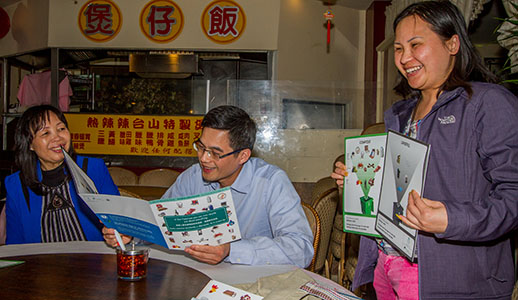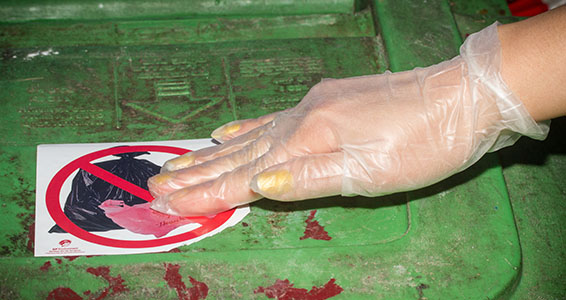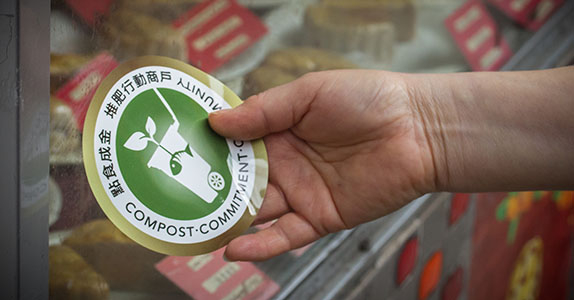In May of 2013, Bay Crossings profiled the San Francisco Department of the Environment’s Environment Now program, which at the time was dispatching job trainees to canvas residential neighborhoods in order to explain best waste-sorting practices to homeowners, with the objective of helping the City reach its goal of zero waste by 2020.

San Francisco’s Environment Now green workforce training program is now working to enlist the support of businesses to help the City meets its goal of zero waste by 2020. Photo by Peter Alexander
By Bill Picture
Published: July, 2014
In May of 2013, Bay Crossings profiled the San Francisco Department of the Environment’s Environment Now program, which at the time was dispatching job trainees to canvas residential neighborhoods in order to explain best waste-sorting practices to homeowners, with the objective of helping the City reach its goal of zero waste by 2020.
Back then, organizers had future plans for outreach to the owners, property managers and tenants of larger multi-unit buildings, whose security gates had prevented Environment Now team members from being able to go door-to-door spreading their green gospel.
A little over a year later, we’ve checked back in with Environment Now Coordinator Cara Gurney to see how the program has adapted to reach these previously hard-to-reach households, and what else can be done on the education front to ensure the City continues on the path of meeting its goal over the course of the next five-plus years.
“We’re still chugging away at it,” Gurney said. “What we learned right away is that for our message to be effective, we have to tailor it to that particular building’s sorting system.”
Convenience is key
Gurney says that for the tenants of large buildings, like the ones in San Francisco’s dense downtown area, doing the right thing can mean carrying waste down long hallways and steep flights of stairs to bins several floors away.
“It’s not always convenient for tenants to recycle or compost, so we try to get into the building before we start knocking on tenants’ doors, to meet with the property managers and look at the system that’s currently in place to see what kind of quick fixes can be made to make it as easy as possible for tenants,” she said.
According to Gurney, some building owners and property managers already know which tenants are the worst offenders, but they lack the resources to educate residents about proper waste sorting methods. “Just providing access to the bins isn’t enough,” she said. “You have to let people know how to use them, and be able to answer their questions. Language and cultural differences can make that a tough job. Thankfully, our team speaks multiple languages, so our message is better or easier received.”
To date, the Environment Now team has canvased over 250 buildings, allowing team members to explain the three-bin system to the tenants of more than 11,500 units.
“We don’t have that many of the big buildings left,” Gurney said. “And the feedback has been so positive. The building owners are happy to have us, the property managers are happy to have us, and the tenants are happy.”
That said, the Environment Now team’s job is an ongoing one. San Francisco’s reputation as a transient city is well-earned, with people coming and going all the time. “Every time a tenant moves out and someone new moves in, we’re essentially back to square one,” Gurney said. “That new tenant has to be reached and engaged in this conversation.”
Educating the business community
Turnover has made enlisting the support of businesses in the City’s zero waste effort equally challenging. Many businesses—particular boutiques and restaurants—open and close their doors in what seems like the blink of an eye. Gurney and her team therefore find themselves seeking the best way to embed the zero waste message into business culture at large so that it outlasts the sign hanging above any one shop door.
“Businesses are here one minute and gone the next,” she said. “Still, our approach has to be the same—a personal one.” Thus, the Environment Now team has been pounding the pavement, speaking with business owners and their employees about how they can keep recyclable and compostable materials out of landfills.
“We’re doing a lot more in-depth trainings with businesses,” Gurney explained. “And the key seems to be getting everyone involved. A lot of times that means doing multiple trainings, because they have different shifts. And again, employees come and go, so we have to revisit a business periodically to make sure that everyone is trained.”
While Gurney says businesses tend to be more on the ball than households when it comes to sorting due to the incentives that business owners receive for minimizing landfill-bound waste, Gurney says her team is still often surprised by what they find in bins.
“Composting is still a big challenge,” she said. “People are still putting a lot of compostable items, like paper towels and food scraps, into the black bin. We’re surprised by that a lot.”
“We’re also still surprised to see so many plastic bags end up in the blue bins,” she added. “I get it, I guess. It’s plastic; blue is for plastic. But the City doesn’t yet have a process in place for recycling plastic film.”
Green workforce experience under the belt
Gurney reports that 80 percent of the Environment Now graduates have gone on to get jobs, many of them with environmental organizations or green companies. A few have gone on to work for the San Francisco Conservation Corps, where they continue their zero waste efforts. One sits on the board of the West Oakland Greening Initiative. Another is working for an environmental consulting firm.
“Many of them look at this kind of work as a career, versus just a job,” she said. And even for those who land jobs outside of the green realm, Gurney believes the strong communication skills they acquire and hone during the program are a strong and valuable asset.
“This job they’re doing out there isn’t easy,” Gurney said. “In fact, it’s really tough. It’s a mini-performance, you could say. You’re reading your audience, tailoring your message on the spot to suit that audience, and fielding a lot of curveballs. Those skills are transferrable to any job in any industry.”
For more information on the San Francisco Department of the Environment and its Environment Now green workforce job training program, visit www.sfenvironment.org.

Plastic films, such as plastic shopping bags and garbage bags, continue to confuse many San Franciscans, who mistakenly toss them into compost and recycle bins. The City currently has no process in place for recycling plastic films. Photo by Peter Alexander

In-language materials are proving an essential tool for Environment Now team members attempting to educate diverse San Franciscans about best waste-sorting practices. Photo by Peter Alexander

